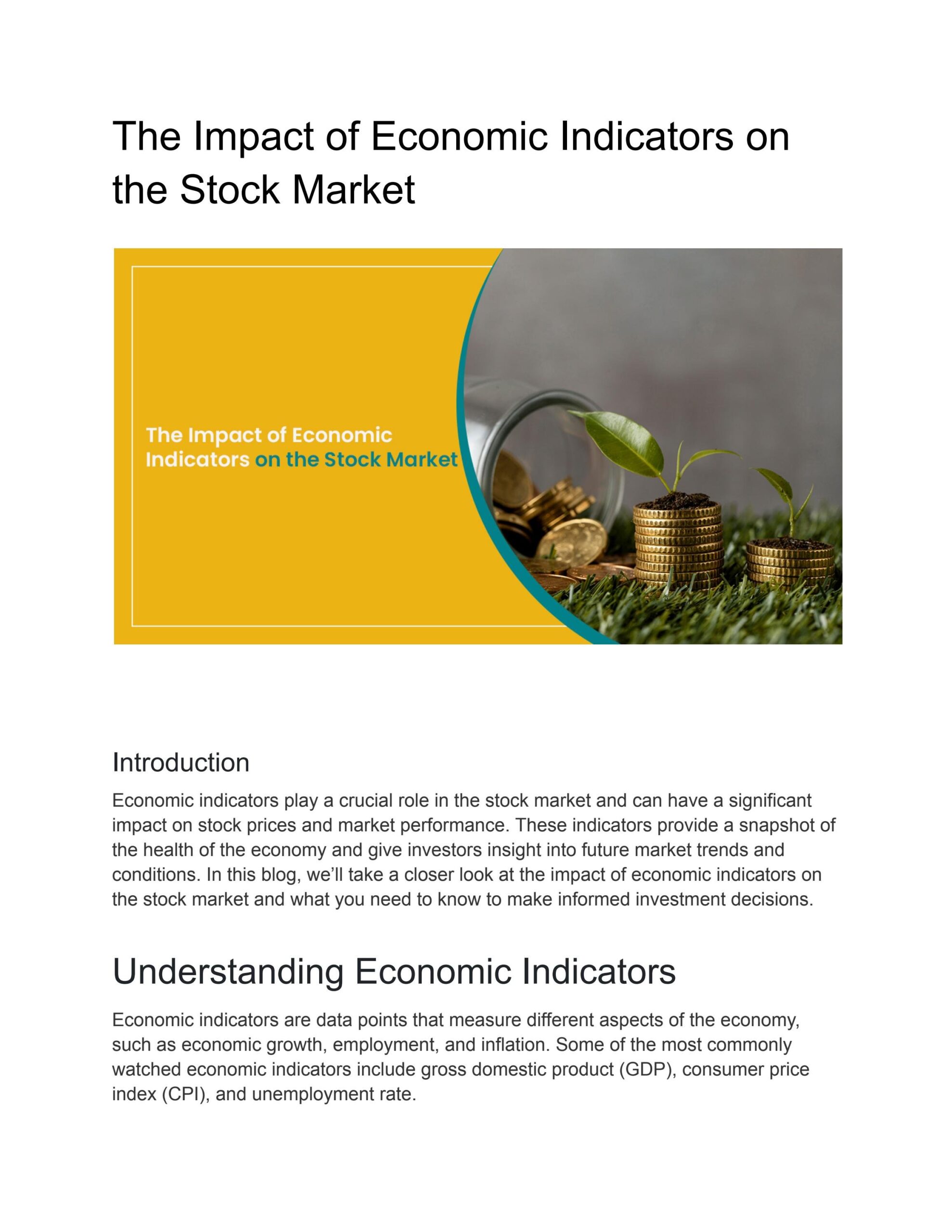Understanding economic indicators and stock performance is crucial for investors looking to make informed decisions. If you’ve ever wondered how these indicators affect stock prices or how to use them to your advantage, this article is for you. Throughout this blog, we’ll delve into the world of economic indicators and explore their relationship with stock performance. By the end, you’ll have a solid understanding of how to interpret these indicators and apply them to your investment strategy. So, let’s dive right in and explore the fascinating connection between economic indicators and stock performance.
Understanding Economic Indicators and Stock Performance
Investing in the stock market can be a daunting task. With the ever-changing economy and the plethora of information available, it’s crucial to have a solid grasp of economic indicators and how they influence stock performance. Economic indicators provide insights into the health and direction of the economy, and understanding their significance can help investors make informed decisions. In this article, we will delve into the world of economic indicators and explore their impact on stock performance.
What are Economic Indicators?
Economic indicators are data points that provide information about various aspects of the economy. They help analysts, investors, and policymakers gauge the overall economic health and predict future trends. These indicators are typically released by government agencies, central banks, and private organizations on a regular basis. Some common economic indicators include:
1. Gross Domestic Product (GDP)
GDP is one of the most widely recognized economic indicators. It measures the total value of all goods and services produced within a country over a specific period. Investors closely monitor GDP as it reflects the overall economic growth and prosperity of a nation. A higher GDP indicates a robust economy, which may lead to increased corporate profits and, consequently, higher stock prices.
2. Consumer Price Index (CPI)
The CPI measures changes in the average prices of a basket of goods and services purchased by households. It helps gauge inflation and the purchasing power of consumers. High inflation can erode the value of money and impact stock prices negatively. Conversely, low inflation or deflation might encourage consumer spending and increase corporate profits, potentially leading to higher stock prices.
3. Unemployment Rate
The unemployment rate represents the percentage of the labor force that is jobless and actively seeking employment. A low unemployment rate signifies a strong labor market, indicating a healthy economy. When people are gainfully employed, they have more disposable income, which can drive consumer spending and company profits – positively impacting stock prices.
The Link between Economic Indicators and Stock Performance
Economic indicators and stock performance are intrinsically connected. Movements in economic indicators can have a direct impact on stock prices and the overall performance of the stock market. Here’s how economic indicators influence stock performance:
1. Anticipation of Economic Indicators
Financial markets are forward-looking, meaning they anticipate future economic conditions. Investors react to economic indicators even before they are officially released, as they try to predict the impact on stock prices. For example, if investors anticipate a positive GDP growth rate, they may start buying stocks in anticipation of a prosperous economy and higher corporate profits, leading to an increase in stock prices.
2. Market Sentiment
Economic indicators help shape market sentiment – the overall feeling or mood of investors. A positive economic indicator, such as a declining unemployment rate, can boost investor confidence, leading to increased buying activity in the stock market. On the other hand, negative indicators, such as rising inflation or increasing unemployment, can create uncertainty and cause investors to sell stocks, leading to a decline in stock prices.
3. Sector-Specific Impact
Different economic indicators affect different sectors of the economy. For example, the housing market may be more influenced by indicators such as housing starts or mortgage rates. Investors need to consider sector-specific economic indicators to gain a comprehensive understanding of how the broader economy influences stock performance within specific industries.
How to Monitor Economic Indicators for Stock Investment
Now that we understand the significance of economic indicators, let’s explore some practical ways to monitor them for successful stock investing:
1. Stay Informed
Keeping yourself updated with the latest economic news and indicators is essential for making informed investment decisions. Follow reputable financial news sources and subscribe to economic data release calendars to stay on top of key updates.
2. Analyze Historical Data
Analyzing historical data of economic indicators can provide insights into patterns and trends that may repeat in the future. It allows investors to identify relationships between specific indicators and stock performance, assisting in making more accurate predictions.
3. Understand Interrelationships
Economic indicators do not work in isolation; they often influence one another. For example, changes in GDP can impact employment rates, inflation, and consumer spending. Understanding these interrelationships can help investors form a more comprehensive view of the economy and its potential impact on stock performance.
4. Utilize Stock Screeners
Stock screeners are tools that allow investors to filter stocks based on specific criteria, including economic indicators. By using stock screeners, investors can identify companies that are well-positioned to benefit from favorable economic conditions or sectors that are likely to outperform based on specific indicators.
5. Consult with Financial Advisors
Seeking advice from financial advisors or professionals can provide valuable insights into the relationship between economic indicators and stock performance. They can help interpret complex economic data and guide investors towards suitable investment opportunities based on their financial goals and risk tolerance.
Incorporating Economic Indicators into Investment Strategy
Understanding the impact of economic indicators on stock performance enables investors to create a more robust investment strategy. Here are some approaches to consider when incorporating economic indicators:
1. Long-Term Investing
Long-term investors typically focus on fundamental analysis and macroeconomic factors such as GDP, inflation, and interest rates. These investors often have a buy-and-hold approach, as they believe in the long-term growth potential of the economy and the companies they invest in.
2. Trend Trading
Trend traders analyze economic indicators and stock price trends to determine the direction of the market. They aim to identify upward or downward trends and ride the momentum, buying during bullish economic conditions and selling during bearish economic conditions.
3. Sector Rotation
Sector rotation involves shifting investments between different sectors based on economic indicators. For example, if economic indicators suggest a slowdown in the technology sector, investors may rotate their investments into sectors that are expected to perform better, such as healthcare or consumer staples.
4. Value Investing
Value investors seek undervalued stocks that have the potential to increase in value over time. They may analyze economic indicators to identify sectors or companies that are temporarily out of favor but have strong fundamentals. By buying these stocks at a discounted price, value investors aim to profit when the market recognizes their true value.
In summary, understanding economic indicators and their relationship with stock performance is crucial for successful investing. By staying informed, analyzing historical data, and considering interrelationships, investors can make informed decisions and tailor their investment strategies accordingly. Incorporating economic indicators into investment strategies allows investors to navigate the ever-changing market landscape with more confidence and potentially achieve their financial goals.
Economic Indicators Explained in One Minute: From Forex & Stock Trading to Macroeconomics
Frequently Asked Questions
Frequently Asked Questions (FAQs)
What are economic indicators and how do they affect stock performance?
Economic indicators are statistics used to measure the overall health and performance of an economy. They provide valuable insights into various aspects such as inflation, employment rates, consumer spending, and GDP growth. These indicators can have a significant impact on stock performance as they reflect the overall state of the economy, influencing investor sentiment and market trends.
Which economic indicators should I pay attention to when analyzing stock performance?
While several economic indicators hold relevance, some key ones to watch for when assessing stock performance include GDP growth, unemployment rate, inflation rate, interest rates, consumer spending, and corporate earnings. Monitoring these indicators can provide insights into the overall economic outlook and help investors make more informed decisions.
How does GDP growth impact stock prices?
GDP growth measures the rate at which a country’s economy is expanding. Positive GDP growth is generally associated with increased consumer spending and business profitability, which can lead to higher stock prices. Conversely, negative or stagnant GDP growth may result in decreased investor confidence and lower stock prices.
What role does the unemployment rate play in stock performance?
The unemployment rate indicates the proportion of the labor force that is unemployed but actively seeking employment. A high unemployment rate can signal weak economic conditions and reduced consumer purchasing power, which may negatively impact stock performance. Conversely, a low unemployment rate suggests a healthier economy and can positively influence investor sentiment and stock prices.
How does inflation affect stock performance?
Inflation refers to the general increase in prices of goods and services over time. Moderate inflation can be positive for stock performance as it typically indicates economic growth. However, high or rapidly rising inflation can erode the value of future earnings and decrease consumer purchasing power, potentially leading to lower stock prices.
What impact do interest rates have on stock prices?
Interest rates play a significant role in stock performance. Lower interest rates make borrowing cheaper, encouraging business expansion and consumer spending, which can drive up stock prices. Conversely, higher interest rates can increase borrowing costs, impacting business profitability and consumer spending, potentially leading to lower stock prices.
How does consumer spending influence stock performance?
Consumer spending is a key driver of economic activity, and it directly impacts stock performance. When consumers have more disposable income and confidence in the economy, they tend to increase spending, which can boost company revenues and drive up stock prices. On the other hand, reduced consumer spending can negatively affect stock performance.
What role do corporate earnings play in stock performance?
Corporate earnings reflect a company’s profitability and financial health. Positive earnings growth is often associated with higher stock prices, as it indicates a company’s ability to generate profits and reward shareholders. Conversely, declining or negative earnings may result in lower stock prices, as investors may perceive the company as less attractive for investment.
Final Thoughts
Understanding economic indicators and their impact on stock performance is crucial for investors and market participants. By analyzing economic indicators such as GDP growth, inflation rates, and unemployment figures, investors can gain insights into the overall health of the economy and make informed decisions about their investments. These indicators provide valuable information about the current and future trends in various sectors, allowing investors to anticipate market movements. By staying updated on economic indicators, investors can effectively navigate the stock market and enhance their chances of achieving favorable returns. Consequently, understanding economic indicators and their relationship with stock performance is an essential skill for investors seeking to make informed decisions.



